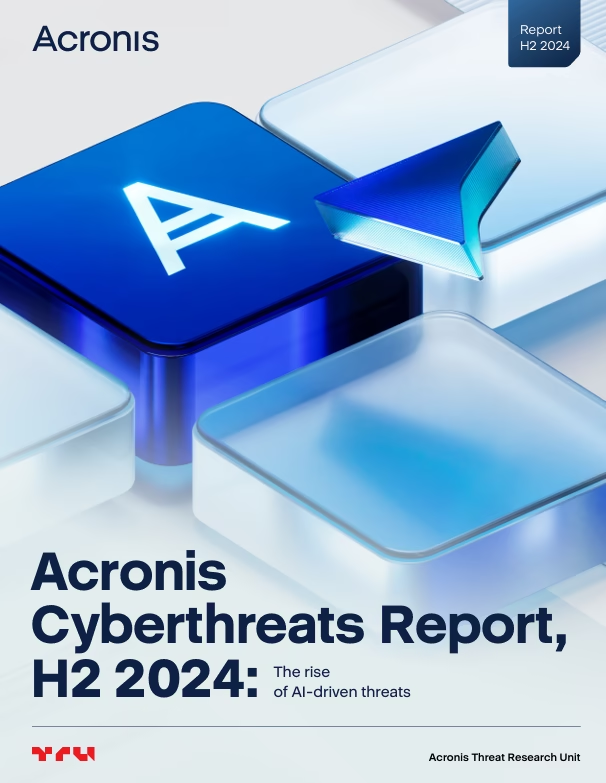This report, published by Acronis in December 2024, provides a comprehensive overview of the global cyberthreat landscape during the second half of 2024. It covers key findings, trends, and predictions for the future. Here’s a detailed summary.

Introduction and Summary
- This biannual report covers the global threat landscape as observed by Acronis’ Threat Research Unit (TRU).
- It’s based on data collected from over 1,000,000 endpoints worldwide, with a focus on Windows operating systems.
- Key findings:
- The United Arab Emirates, Singapore, and Italy were the most targeted countries for malware attacks in December 2024.
- Acronis blocked over 48 million malicious URLs in Q4 2024, a 7% increase compared to Q3.
- 31.4% of received emails were spam, and 1.4% contained malware or phishing links.
- Key Cyberthreats and Trends
- Ransomware:
- A 5% increase in ransomware attacks targeting critical industries like transportation, healthcare, and manufacturing.
- Attackers are using personalized tactics and AI-driven strategies to exploit vulnerabilities.
- MSPs are becoming a prime target, with attackers exploiting their remote management tools (RMMs).
- Phishing and Malicious Emails:
- The number of email-based attacks detected in the second half of 2024 increased 197% compared to the same period in 2023.
- Phishing attacks are becoming more sophisticated, leveraging social engineering techniques and exploiting trusted platforms.
- Data Breaches:
- Data breaches continue to dominate, with financial services, healthcare, retail, utilities, and technology sectors being significantly impacted.
- Third-party service providers are often the weak links in cybersecurity defenses, leading to major breaches.
- AI-Generated Cyberthreats:
- AI tools are being increasingly used to launch cyberattacks, creating malicious content and automating attacks.
- This includes AI-powered malware development, spear-phishing campaigns, and AI-driven software supply chain attacks.
- North Korea’s cyber operations have become more sophisticated through the integration of AI, using deepfakes and fake LinkedIn profiles.
2. General Malware Threats
- Trojans are the most common malware type, accounting for 79% of blocked threats.
- The number of new malware samples is increasing, showcasing the growing sophistication and versatility of attack methods.
- The United Arab Emirates, Singapore, and Italy had the highest normalized malware detection rates in December 2024.
3. Vulnerabilities Discovered in Products of Key Software Vendors
- The second half of 2024 saw a significant increase in software vulnerabilities.
- Cross-site scripting (CWE-79) remains the most dangerous software weakness.
- The report highlights notable vulnerabilities discovered in products from Microsoft, Adobe, and Google Chrome, emphasizing the need for timely updates and robust security measures.
4. Predictions for 2025
- Ransomware:
- Ransomware will continue to dominate, with attackers targeting cloud backups and using AI to automate attacks.
- Double extortion will become more prevalent.
- Key Investment Areas:
- Organizations will prioritize investments in XDR and EDR to protect against advanced cyberthreats.
- Cloud security will be a key focus, addressing misconfigurations and adopting cloud-native security solutions.
- Zero trust architecture (ZTA) and Identity and Access Management (IAM) will be crucial for securing access.
- AI’s Role:
- AI will be used by cybercriminals to automate attacks, create deepfakes, and exploit vulnerabilities in AI systems.
- AI will also enhance threat detection and automated incident response for defenders.
- Nation-State Sponsored Attacks:
- These attacks are expected to increase, with conflicts in regions like Eastern Europe, the Middle East, and the Indo-Pacific likely to see cyber tools used for destabilization.
- MSPs will become prime vectors for attacks targeting broader geopolitical objectives.
- Challenges Faced by MSPs:
- Securing complex IT environments, including hybrid cloud models and IoT devices, will be a challenge.
- Protecting against supply chain attacks and complying with data protection regulations will be crucial.
- The cybersecurity talent shortage will continue to be an issue.
- Emerging Trends:
- Quantum computing will pose a new challenge to encryption methods, requiring exploration of quantum-resistant cryptography.
- AI-powered malware will become more sophisticated, evading detection and adapting to changing defenses.
- The rise of ARM-specific malware is a growing concern.
Acronis Recommendations to Stay Safe
- Keep passwords and working spaces private.
- Patch your OS and apps regularly.
- Be vigilant against phishing attempts and don’t click suspicious links.
- Ensure your cybersecurity solution is properly configured.
- Control the risks related to AI usage.
- Implement an integrated cyber protection solution that combines XDR, EDR, anti-malware, DLP, email security, vulnerability assessments, patch management, RMM, and backup capabilities in a single agent.
We have also sent several questions, directed to Kelly Johnson, General Manager, Acronis ANZ Region. Subsequent responses will be published accordingly.

